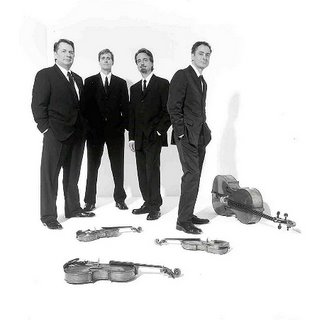Emerson Plays Sheng
This review is an Ionarts exclusive. The second of the Emerson String Quartet’s concerts for the Smithsonian Resident Associates, at the National Museum of Natural History, was similarly programmed as its first one in September. Two war horses framed a composition where the ink was hardly dry. Co-commissioned for the Emerson Quartet by SUNY-Stony Brook, Stanford University, and the University Musical Society at the University of Michigan, Bright Sheng’s 2007 String Quartet No. 5: The Miraculous is inspired by Bartók’s Miraculous Mandarin Suite. The piece opens with pizzicati vibrantly dotting the vivid texture and wily off-putting rhythms. The instrumentalists seemed to play in different tempi, while unisono passages in one pair of strings contrasted with the other couple playing harmonics. Later, a dialogue of gentle glissandi was heard. The form of The Miraculous was difficult to decipher as the texture changed at least every few minutes, which succeeded in keeping the audience alert. Sheng’s attractive work ended with a single, distinctive pizzicato note from first violinist Eugene Drucker (who has recently published a novel), much like it had begun with one such note plucked by cellist David Finckel.
The second of the Emerson String Quartet’s concerts for the Smithsonian Resident Associates, at the National Museum of Natural History, was similarly programmed as its first one in September. Two war horses framed a composition where the ink was hardly dry. Co-commissioned for the Emerson Quartet by SUNY-Stony Brook, Stanford University, and the University Musical Society at the University of Michigan, Bright Sheng’s 2007 String Quartet No. 5: The Miraculous is inspired by Bartók’s Miraculous Mandarin Suite. The piece opens with pizzicati vibrantly dotting the vivid texture and wily off-putting rhythms. The instrumentalists seemed to play in different tempi, while unisono passages in one pair of strings contrasted with the other couple playing harmonics. Later, a dialogue of gentle glissandi was heard. The form of The Miraculous was difficult to decipher as the texture changed at least every few minutes, which succeeded in keeping the audience alert. Sheng’s attractive work ended with a single, distinctive pizzicato note from first violinist Eugene Drucker (who has recently published a novel), much like it had begun with one such note plucked by cellist David Finckel.
Beethoven’s String Quartet in C Minor, op. 18, no. 4, purveys the serious, often dark nature many composers associate with that particular key. The first of the two middle-movement allegrettos, the Scherzo: Andante scherzoso quasi allegretto features a charming fugal opening and proved a nice contrast to the dark first movement. The Emerson’s choice of tempo seemed perfect. The third movement Menuetto: Allegretto is more vigorous, with its fun accents driving the movement with increased speed and intensity to the end. The final Allegro movement contains beautiful suspensions and an ornamented folk-like tune. The Emersons conveyed plenty of humor and joy as the work accelerated to its end. Alas, first violinist Eugene Drucker’s intonation was troublesome.Available at Amazon:
Brahms, String Quartets and Piano Quintet, Emerson Quartet, Leon Fleischer (May 8, 2007)
Philip Setzer assumed the role of first violinist in Brahms’s String Quartet in B-flat, op. 67. (The Emerson Quartet's recording of the Brahms quartets has been reviewed at Ionarts and by Jens Laurson for WETA.) Setzer sparkled in the first movement and soared beautifully above the rest of the ensemble in the second. Featuring the characteristic restlessness often present in Brahms’s works, violist Lawrence Dutton put his rich tone to an involving, story-telling effect.
The remaining concerts by the Emerson Quartet on the Smithsonian Resident Associates series are scheduled for January 19 and May 10. Violist Lawrence Dutton will give a solo recital on February 2. All concerts begin at 6 pm, in the auditorium of the National Museum of Natural History.




















































No comments:
Post a Comment